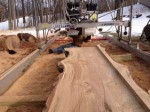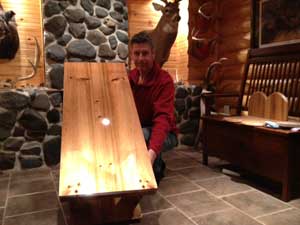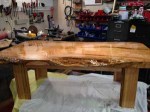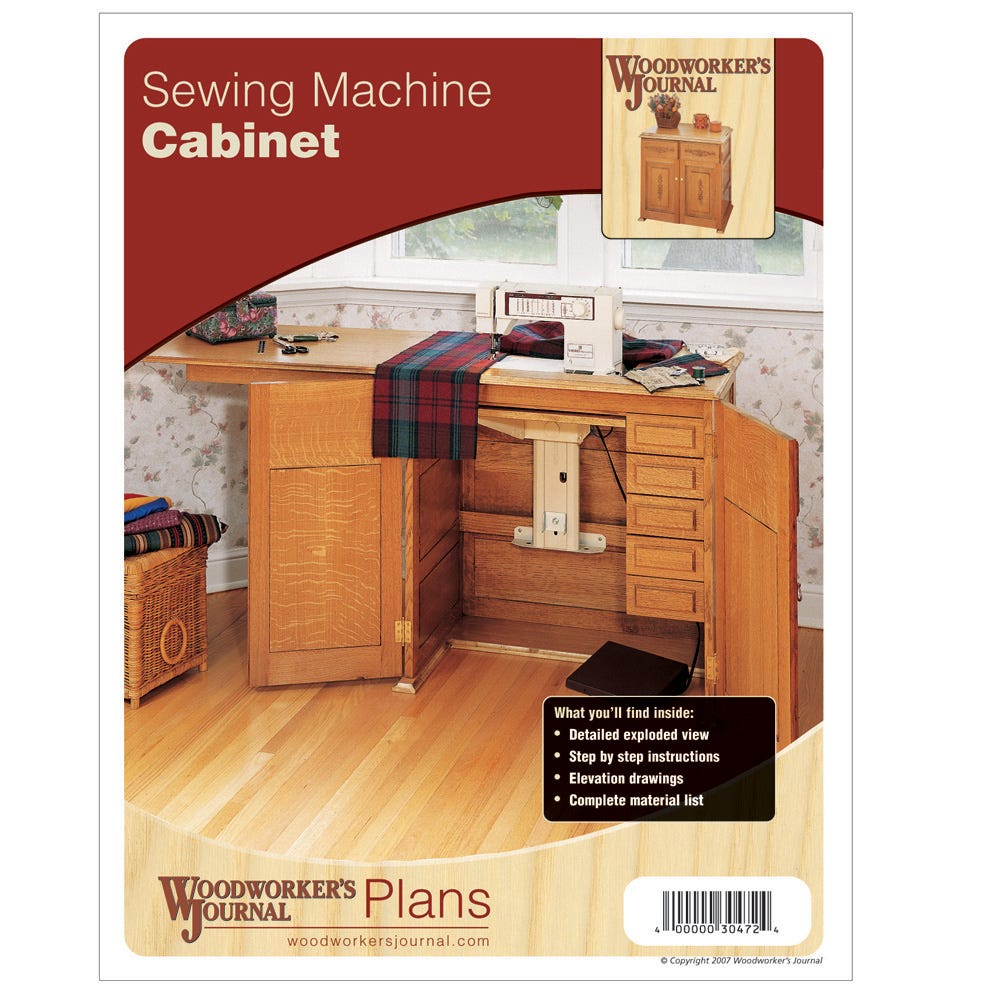
In his editorial last time out, Rob shared that lately, he has found fun in working with thick slabs of lumber, and asked if anyone else was working with it. – Editor
Some agreed that it’s fun to work with large slabs of lumber.
“I wholeheartedly agree with the fun factor of working with thick boards. I am fortunate to be able to saw my own lumber and have near unlimited access to Oregon white oak and big leaf maple. Wide slabs provide options not only for the aesthetics of heavier looking construction, but options for book-matching are also great to have. I live and die by live-edged Oregon big leaf maple: burled, figured, spalted, it’s all good. If I could work with only one species, this would be it. In fact, the projects I make are over 90 percent maple. From tables to boxes, it is my go-to species, and thick boards allow limitless options. Since I plan to be cremated when the day comes, my remains will be in a big leaf burl container of my own creation, but that should be many years in the future, Lord willing.” – Mike Wolff
“Just love the thick stuff. Built a 7 foot trestle dining table using 1-3/4 mahogany. Yes, lumber was a bit pricey, but it is absolutely gorgeous and the envy of all who see it. Have been told by knowledgeable other furniture makers that if it were to be sold (wife will never permit that), it would bring in excess of $6,000. Have used thick stuff for chair seats, also with great results. Currently, my son is now fashioning his kitchen table out of 3-inch sapele, just had to try to ‘outdo’ old Dad, I guess. My 7+ foot desk at my office is handmade out of 3-inch live edge and natural shaped California redwood throughout. There is something seemingly magical or mystical, regal and classy when something is built out of thick ‘stuff.'” – Bill Wennen
“Here is a table I made this winter. Love the look of this type of lumber. Had slabs cut from my own trees.” – Richard Taylor
Others had issues with availability, price or other factors. – Editor
“Finding such lumber is difficult. I’ve built probably a dozen candlestands that call for 1-1/2″ thick platform, and in all but one instance I had to laminate wood to get the desired thickness; it works, but it’s quite challenging to get grain matches; the recipients don’t notice the differences in grain, but I do. The best luck I’ve had is at sawmills where you can find 8/4 shorts, or request special milling. There’s a downed walnut tree in my back yard, and the sawyer is willing to mill some of it into eight quarter, and I can’t wait!” – Lyle Hestermann
“I would love to find a local source for thicker wood for my projects! I’m renovating a home that was built in 1909, and there is a detail that I need to replace that needs 8 quarter redwood, but the only thing available locally is 4 by, and that means that I’ll be left with a little over 4 quarter stock as scrap! I’ll try to use the scrap to make moldings that broke while I was removing them. The last project that needed thicker slabs was one that I ordered some 6 quarter white oak over the Internet, worked great for that small project.” – J. Eric Pennestri
“How about just too old to lift that much? Just kidding, I still can hold my own even if I’ll never see 77 again. I do try to limit the size of the projects a bit more so that I don’t have to get some transcript/slave labor to help. That said, if I need a large ‘slab’ I won’t hesitate to get with the project.” – R. L. Hoyle
“Regarding your comment in Issue 351 about using thick pieces of wood for projects, I have to share with you an experience I recently had. I went to my favorite wood supply place to get some oak for a project, and the guy said, ‘Come with me, I want to show you something.’ So I followed him back out into the warehouse, and we walked up to this bubinga board. I didn’t have my tape with me, but I estimate that that thing was about 6″ thick by 4 feet wide, and something like 12 feet long. It was HUGE!! Boy, couldn’t I have a field day with that! I asked the price, and he said 2 grand. The only problem for me (besides the 2 grand) is, I have no way to drag it home, no way to handle it when I got it there, and no equipment large enough to work it, but I bet I could come up with some good projects to use it for. I just wanted to share.” – Don Haff
“I have often looked over and fondled the larger boards in the lumber section. However, it is all a dream as I could never afford $1,000 for 2 ft by 4 ft waney-edged slab. It’s easy to see ideas and dreams. One of us is living in a different world. If many readers can buy this type wood, I’m reading in the wrong place. You didn’t say if you got the boards free, but if you are buying them, it was pretty rude to rub our noses in it. There was no story other than ‘Look what I have.'” – Larry Wallace
Rob responded to a question on price. – Editor
“I am sorry if my editorial came off as snooty. That was not my intent. I buy my thick stock from local sawmills, and so it is usually not crazy expensive. Sometimes I have to wait to use it, because it is still a bit green. Even then, sometimes I just use it and let the cracks become part of the ‘design.’ We did a couple of articles in our print magazine last year on buying lumber from local sawmills and making your own lumber. It can save you money, and give you options that don’t exist in standard lumberyards. You are also increasing your risk that the lumber might not be at the quality level you might expect elsewhere. I recently bought a 3.5 thick slab of ash that was about 20-inches wide and 7 feet long for about $100. So, in the neighborhood of $3 a board foot. Not a huge deal, but I got good value for my buck.” – Rob Johnstone
Others had different perspectives – on the need to work with large slabs of wood or, in fact, what constituted a “large” slab. – Editor
 And still more readers shared where they find big slabs, why they like them – and photos. – Editor
And still more readers shared where they find big slabs, why they like them – and photos. – Editor

“Here’s the start of my big slab bar top I’m making for a friend who had a 200-year-old white oak blown down in his yard last spring. I cut two slabs from the center and will use the one you see here for his bar top. I also had cookies cut for round table tops. The slabs are in the kiln drying and should be done soon. I also attached a table made from reclaimed 300-year-old pine from Lake Superior.” – Tom Bodin
“Thick slabs are very popular in New Zealand for rustic furniture, often outside, but also for large dining tables, coffee tables, etc. Part of the attraction is often the presence of wany edges emphasizing the natural nature of the material emphasizing our connection with the outdoors. Materials are still readily available, however generally sourced from domestic situations rather than a traditional lumberyard – mainly TradeMe (New Zealand eBay); however, at $400-$500, you can get a top for a table needing little more than surface finishing.” – Nigel Kenny
“In the past year, I have started working some with slabs. I think they look great! Last fall, I purchased a slab of sycamore from a mill near Black Mountain, North Carolina. 1-2/4 thick, 20-28″ wide and 13′ long with a lot of swerving grain, and very heavy. I selected the best looking 5′ length, and that became a new coffee table. It was not flat, and I couldn’t locate anyone with a planer that could handle the 28″ width. I made a jig so I could slide my router in two dimensions. That worked very well and much quicker than I expected to get both sides parallel and flat. I finished it with three coats of clear Danish oil. It is now in our living area and has received many positive comments. At the present, I’m working on a walnut slab cocktail table for the back deck. To my taste, the live edges look great and not like they came from a store.” – Larry Goodgion
“I have a 2.5″ x 14″ x 6′ slab of rough white oak which I collected over 40 years ago from a construction site. Contractors often discard these shoring planks after finishing jobs or will sell them for a reasonable price. One of these days, I’m planning on using mine for a shaving horse. Better do it soon since I turn 73 this coming October. Keep up the good work.” – Tom Cuccia
Setting Router Bit Depth
This reader wasn’t sure how the homemade router bit depth jig featured in the last issue of the eZine was the best way to set the bit depth. – Editor
“Your homemade router depth gauge is an excellent idea, but what you did not cover in the video was how to drill the holes in the jig to the precise depth needed. It would seem to me that it would be more difficult to do that than it is to set the router depth by other means.” – Selwyn Adelson
Solvents to Clean Steel
Another reader wanted to share his experience as a chemist in light of last issue’s question and answer on the Best Waterproof Adhesive for a Wood/Metal Bond. – Editor
“I spent 47 years as a coatings chemist formulating and applying you name it. You told the gentleman to clean his steel with solvent before applying the epoxy. The solvent you use to clean the steel is important. Mineral spirits, naphtha, etc. can contain enough mineral type oils and paraffins to cause a problem. Aromatic hydrocarbons (xylene, toluene, aromatic 100, 150) can contain enough petroleum contaminants to cause a problem.
“A better choice would be a ketone (acetone or methyl ethyl ketone, etc.). The best choice may not be available to an individual: chlorinated hydrocarbons (perchlorethylene, trichloroethylene, trichloroethane) will do a better job of removing oils and residues from the surface of the steel.” – Richard Melton
Toy Envy
The Road Scraper Toy from last issue’s Readers Project Gallery had at least one other reader putting it on his wish list. – Editor
“What a beautiful toy. I want one … forget the kids! Congratulations to William Kirby for his patience and skill!” – Robert R. Shaffer
Tips from Turners
A couple of experienced turners shared their experience in relation to some of the information from last issue’s quiz on the topic of green woodturning. – Editor
“I really enjoy the new quiz feature. I am a pro turner and was disappointed to only get 80 percent on this one. I take exception to the answer for ‘if you green turn a bowl to finished thickness, how thick should it be…’ (or words to that effect). My response was the thickness that best matches the form. The ‘correct’ response was all of the above (if memory serves). One of the responses was about 1/2-inch or so. I turn a lot of figured big leaf maple – a 1/2-inch wall on one of these green turnings (assuming a 10-12 inch diameter bowl) would likely result in failure due to cracking – voice of experience here – lost a couple and then I got smart. The other one I got wrong was the emulsifier. I selected watery paint, which is just as valid (and cheaper – something near and dear to my Scottish heritage). Good stuff all in all.” – Neil MacPhedran
“I took the quiz on green woodturning in your latest eZine, but found that for several questions, what I felt was the best answer wasn’t available to choose! When roughing out green blanks, I find the best way to season the resultant items is to pack them in their own green shavings in a mesh-sided box, and leave them in a cool, airy place for as long as necessary. My present box is a 1,500 x 1,000 x 1,000 mm frame built on a shipping pallet, and covered with 20mm vermin-proof netting. The key benefit of this approach is that you can chuck a blank with a really eccentric grain orientation, leave substantial wall thickness, and still have a dried, rough-turned object that can be finished without cutting through a wall!” – Graeme Cole








